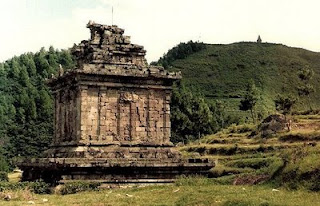Karimun Jawa Island-Central Java
Karimun National Park is a cluster of 27 islands that have the type of lowland rain forest ecosystem, seagrass, algae, coastal forests, mangrove forests and coral reefs.
Plants that characterized National Park karimunjawa namely dewodaru (Crystocalyx macrophyla) found in lowland rain forest. Groups of algae that can be found consisting of three groups: green algae, brown algae and red algae. Coastal forest and mangrove forest is characterized by the existence of almond (Terminalia cattapa), sea pine (Casuarina equisetifolia), teak sand (Scaerota frustescens), setigi (Strebus asper), sea hibiscus (Hibiscus tiliaceus), and black mangrove (Rhizophora mucronata).
Types of coral reefs in the National Park is a coral reef beach karimunjawa / edge (fringing reef), coral reef barrier (barrier reef) and a few taka (patch reef). Genus, species richness reached 51, more than 90 species of hard corals and 242 species of ornamental fish. Two types of biota that protected the roots Bahar / black corals (Antiphates spp.) And red coral (musica Tubipora).
Plants that characterized National Park karimunjawa namely dewodaru (Crystocalyx macrophyla) found in lowland rain forest. Groups of algae that can be found consisting of three groups: green algae, brown algae and red algae. Coastal forest and mangrove forest is characterized by the existence of almond (Terminalia cattapa), sea pine (Casuarina equisetifolia), teak sand (Scaerota frustescens), setigi (Strebus asper), sea hibiscus (Hibiscus tiliaceus), and black mangrove (Rhizophora mucronata).
Types of coral reefs in the National Park is a coral reef beach karimunjawa / edge (fringing reef), coral reef barrier (barrier reef) and a few taka (patch reef). Genus, species richness reached 51, more than 90 species of hard corals and 242 species of ornamental fish. Two types of biota that protected the roots Bahar / black corals (Antiphates spp.) And red coral (musica Tubipora).
Other protected marine life such as goat's head (Cassis cornuta), triton trumpet (Charonia tritonis), hollow nautilus (Nautilus pompillius), stone game (Turbo marmoratus), and six kinds of clams.
Diversity of terrestrial wildlife in national parks is not very high compared with aquatic animals. Terrestrial animals which are common among other deer (Cervus timorensis subspec), long-tailed macaques (Macaca fascicularis karimondjawae); 40 species of birds such as Green Imperial-pigeon (Ducula aenea), white belly sea eagle (Haliaeetus leucogaster), trocokan / Yellow-vented Bulbul (Pycnonotus goiavier ), parakeet (Psittacula alexandri), hawksbill (Eretmochelys imbricata), green turtle (Chelonia mydas), and snakes edhor. White belly sea eagle is an endangered wildlife species in the world.
Around the island there Kemujan INDONO Panama wrecks that sank in 1955, where at this time become suitable habitat for reef fish and dive sites (Wreck diving).
From the group of islands totaling 27 units, five of which have been uninhabited island of Karimun Jawa, Pulau Kemujan, Parang Island, Mosquito Island, and Island Genting. Karimun Island became the center district, a distance of ± 83 km from the town of Jepara (center of the famous wood carving artisans in Indonesia).
From the group of islands totaling 27 units, five of which have been uninhabited island of Karimun Jawa, Pulau Kemujan, Parang Island, Mosquito Island, and Island Genting. Karimun Island became the center district, a distance of ± 83 km from the town of Jepara (center of the famous wood carving artisans in Indonesia).








































